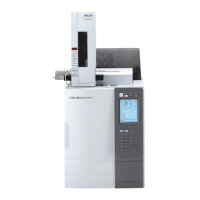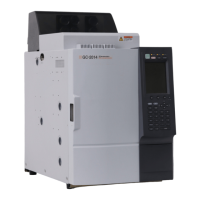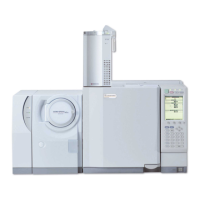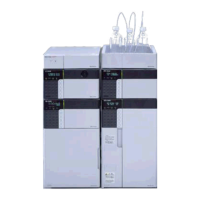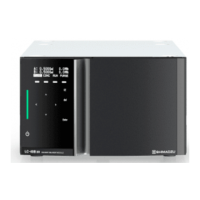114
2. Adjustment in the high mass-number range
This instrument incorporates an auto-tuning function that conducts mass-number calibration
at m/z614. Mass-number displacement is rare in the normal range of operation (up to
approximately m/z700.)
However, displacement from the calibration at m/z is possible in the high mass-number
range.
Ensuring accurate calibration in the range m/z700 to m/z1000 requires manual calibration
by injecting a triazine (Tris(perfluoroheptyi)-S-triazine) high-mass-number standard sample
into the column.
Procedure
Instrument conditions
Sample: triazine 1% solution in acetone, ultrasonically mixed
INJ: 250
M
C
COL: 50
M
C (1 min.)-5
M
C /min-100
M
C (1min)-30
M
C /min-250
M
C (10min)
I/F: 250
M
C Ion source: 200
M
C
Column head pressure: 100kPa Total flow rate: 30mL/minute
Splitless injection (1 min. sampling)
Triazine flow time is approximately 3 minutes between minute 11 and minute 15
c Tak e 1 µL triazine sample into a syringe and inject it into INJ. Wipe any sample from
the syringe tip before injecting the sample.
d Monitor m/z771, 886, and 1016 on the Peak Monitor window. Leave the filament off
for the first five minutes after sample injection, turn the filament on, and wait for the
peaks to appear.
e The triazine peak can be seen for the three minutes between minute 11 and minute 15.
Check the mass number (within C0.3 mass) and resolution (FWHM resolution 0.1M
max.). Conduct manual compensation, if necessary.
f After making this check, increase the column temperature to 250
M
C to drive out the
triazine. Ten minutes at 250
M
C is insufficient, conduct this process for 1 hour at
250
M
C.
Caution) Traces of the injected triazine may remain in the sample lines and
hinder subsequent analysis. Allow the column to age overnight at
250
M
C before conducting ultramicroanalysis.
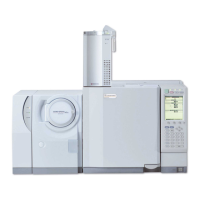
